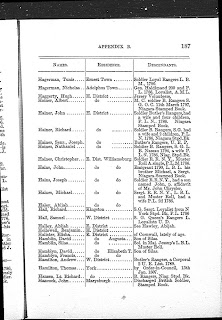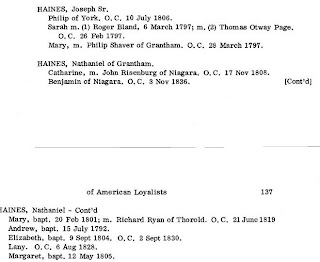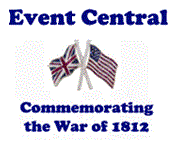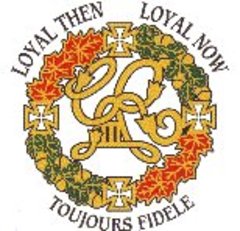 Joseph Haines, Sr. was born in Germany and immigrated to New York about 1760. He had a lease from Sir Wm. Johnson for a tract of 100 acres of land in Tryon County at a cost of 6 pounds a year. There, he raised seven children until the outbreak of the Revolutionary War, when his three sons went to serve in the King's Royal Regiment of New York. One of his sons was killed. He later joined John Butler's Corp of Rangers along with two of his three remaining sons. He and his family fled to Quebec with the Butler's Rangers in 1781 and remained at Lachine for four years until they settled in the Niagara region.
Joseph Haines, Sr. was born in Germany and immigrated to New York about 1760. He had a lease from Sir Wm. Johnson for a tract of 100 acres of land in Tryon County at a cost of 6 pounds a year. There, he raised seven children until the outbreak of the Revolutionary War, when his three sons went to serve in the King's Royal Regiment of New York. One of his sons was killed. He later joined John Butler's Corp of Rangers along with two of his three remaining sons. He and his family fled to Quebec with the Butler's Rangers in 1781 and remained at Lachine for four years until they settled in the Niagara region.Joseph Haines and son-in-law, Peter Whitney,purchased a mill at the Four-Mile creek in 1801. It was deeded to his grandson, James Haines, son of Philip, in 1818 after Philip's death in a fire in York.
Joseph Haines, Sr and ?? had the following children:
i. Nathaniel Haines, born about 1765
ii. ______ Haines, died in Rev. war
iii. Joseph Haines, Jr., born about 1767, died Sept. 21, 1853
iv. Margaret Haines, born about 1777
v. Philip Haines, born about 1779
vi. Sarah Haines, born about 1768, died 1852
vi.Mary Haines, born about 1783, died June 5, 1849

United Empire Loyalists, Part II
The Evidence.
988. Claim of
Name: Jos. Hanes , late of Tryon Co.
Claimt. says he was at Le Chine in Fall
'83 & the ensuing Winter.
Is a Nat. of Germ.
Came to America 23 years ago.
Lived at Johnstown on the Mohawk .
Came into Canada in '81 .
Three sons joined Sir John Johnson , 1 was killed; two others served till end of the War.
Came into Canada because the Rebels persecuted him.
They would have taken his life if he had not came away.
Lives 4 miles from
Montreal , but has land in 4 Township.
Had a Lease from Sir Wm. Johnston of 100 acres,
Lease forever, paying Rent £6 pr. ann.
Cleared 50 acres.
Built house, Barn, &c., planted an orchard.
Lost his utensils, furniture, 3 Horses, 3 Cows, 24 sheep, grain, 300 Boards.
The Rebels took some, but his wife disposed of some & brought some to
Canada .
'An Annotated Nominal Roll of the Butler's Rangers 1777-1784 with Documentary Sources"
Lieutenand Colonel William A. Smy, OMM,CD,UE
Haines, Joseph. Private. ["Hains"," Haynes"]Senior. From Tryon County, NY, where he had 100 acres from Sir William Johnson. His three sons served in the King's Royal Regiment of New York. In Sep 1783, he and his wife, one boy and three girls over twelve, were drawing rations as refugees in Quebec. Settled at Lachine, Quebec. In Jan. 1797 he petitioned for land stating that he had arrived in the Province in 1786 with a wife and six children. To date, he had only received 200 acres on land in the Township of Niagara. he was granted an additional 350 acres as family lands. He estimated his war losses at 265 pounds sterling ($19,810 in 1991 US dollars). Children: Nathaniel, Joseph, Mary, Margaret, Sarah, Philip. All born in New York colony. Philip, Sarah and Mary granted land as children of UE Loyalist.
Sources:A. British Library -(26) - ADD MSS* - 21826. Return of Loyalists in Canada, 1778-1782.
C. Return Sep 1783
(* these Additional Manuscripts (ADD MSS) are commonly referred to as the Haldimand Papers)
D. Ontario Archives -
(2) Reports of the Department of Public Records and Archives of Ontario
G - Nineteenth Report (Toronto 1930)
E. Published Secondary Sources -
(13) - The Old United Empire Loyalists List (Toronto 1885)
(93) - Gregory Palmer. Biographical Sketches of Loyalists of the American Revolution (London, 1984) (100) - Thomas L. Purvis. Revolutionary America, 1763-1800: Almanacs of American Life (New York, 1995)
Old United Empire Loyalists List - served with Butler's Rangers, Ontario People 1796 -1803 -E.Keith Fitzgerald

Here are excerpts from the book "Millers of the Humber Valley, a study of Early Economy of Canada" by Sidney Thomas Fisher: Haines Mill-
On 6 December 1798 John Lawrence's grist mill on east bank of the Humber (Toronto) near the road to the ferry and including 30 acres on the west bank of the river, between the 2 roads was sold to Peter Whitney and Joseph Haines for 60 pounds, a fair indication that it was heavily encumbered with debt.(pg 60)"Information as to the location of early roads is so sketchy that one must give approximations. In this case, Lawrence specifically mentions the Lake Shore road. The other was probably one later known as the 'Middle Road' which was followed roughly in building the present Queen Elizabeth Highway. (#1,pg 167)
On November 2, 1799, John Dennis charged Reuben Riggs, a carpenter of York, with theft of timber that had come from his shipyard.In January 1800, Riggs was acquitted, "Dennis was on dangerous ground in attempting a prosecution, as his own actions were not above suspicion. In 1791 his neighbour, Joseph Haines, complained to Lieutenant-Governor Peter Hunter that Dennis had no authority to cut timber on private property, Haines wisely let the matter drop. If Dennis was guilty, he was not the only offender, for in 1811, long after Dennis had left the Humber, Philip Haines, who had taken over most of his father's property was threatening to prosecute lumber thieves." (pg 53-54)
"Joseph Haines and his family had made steady progress in developing the mill and surrounding property. Peter Whitney, Haines's partner in the purchase from Lawrence's executors, had left the Humber. He had sold his interest to Haines on 7 July 1801 and on 8 May 1807 he sold the adjoining lots which he had bought from John Wilson on 25 May 1800 to Joseph Haines Jr. The two Haines then owned all property on the east bank of the Humber from John Dennis's shipyard to the Dundas Street crossing, where there was an excellent mill-site which Joseph Haines Jr. wold to William Cooper on 9 May 1807. Cooper promptly erected a grist mill and developed the property so energetically that he place the Haines mill at a disadvantage. In 1815, Joseph Haines Jr., who had gone to Niagara to live, sold the rest of the former Willson property to Cooper.
Joseph Haines showed considerable courage in buying Peter Whitney's share of the grist mill, carrying on the business with the aid on his son Philip, because after Willson left the King's Mill the prospects of development there had faded, although William Jarvis was carrying on a commercial fishery at the mouth of the Humber and John Dennis was busily employed in his shipyard. With Joseph Haines Jr. in possession of the lands to his north, it looked as though the mill might be able to attract customers from that area and the settlement would be developed south and west along the road leading from "the head of the lake" (Burlington Bay) to York. He could not know that once John Dennis had served the government purpose in building a few vessels, the shipyard would be left idle and incorporated into a reserve that was to be hoarded by the government until the middle of the nineteenth century.
"From 1800 until 1807, prospects were good for the Haines Mill. Joseph Haines built a road from his mill to lot 36 where it connected with the road to the ferry. Until 1804 the ferry road was little more than an ill-kept track, but for the next two years there was steady improvements as Joseph Burton and his men widened and drained it, under a contract from the Commissioner of Roads, and ever inveiled some of his men into making some necessary improvements west of the Humber through the hitherto barely drained reserve. Burton had told these men that William Allan, one of the Commissioners for Roads, would pay them and Allan finally agreed to do so. These improvements contributed to the success that Clark and Lymburners had in attracting customers to the rebuilt King's mill. Although the Lymburners continued to attract customers to the area until 1810, Haines began to feel the effects of competition from the two mills at Dundas Street by 1808 and , for a time, there was some competition at Weston where Conrad Countryman ran a small grist mill for which he was given the irons and millstones in 1807. Weston, however, did not become a real competitor on grist milling until 1819.
On 28 November 1810 Joseph Haines braced himself to meet competition by turning the grist mill over to his son Philip who added a saw mill. The heavy increase in lumbering that preceded the War of 1812 made plenty of work for all available mills. Meanwhile, Joseph Haines was providing custom for the grist mill by developing the agricultural potential of his property in a way that attracted tenant farmers, one of whom seems to have been John Chilson. When Philip Haines died on 22 July, 1818, Joseph deeded the mill property to James, Philip's son. In this deed he should point with pride to the houses, outhouses, barns, stables, gardens and orchards that had transformed the place since Lawrence's time . A cherry orchard on this property was said to date from Jean-Baptiste Rousseau's tenure during the French regime.
Shortly before Joseph Haines made over the southern part of his property to his grandson, James he sold the northern portion to Daniel Tiers, an innkeeper. Two years later, this northern portion was bought by the Hon. James Baby, who's name has become attached to the promontory that distinguishes it, Baby Point had sheltered the mill since John Lawrence had built it, and was to continue to do so, first for the Haines family then for two distinguished millwrights, Friend Wilcox and Rowland Burr and finally for William Gamble. The activities of Wilcox, Burr and Gamble belong to a later stage of the milling economy.
"By the time James Haines took over the mill, the grist mill at Dundas Street had so far outstripped him it is probable he confined himself to saw-mill operations. Hemmed in as he was with large reserves south of him and on the west bank opposite to him, he had little opportunity to expand. His uncle had sold the northern mill-site and its lands to Cooper and very little had been done to keep up the road to the ferry, In spite of the hard work that the Haines family had put into the mill and surrounding property, the Magistrates, in Quarter Sessions, dealt them a severe blow. In 1810 the overseer of the roads for the Humber was directed to use all the road money and all labour due from the settlers west of York in building and improving a road from James Given's house in Lot (Queen) Street to the Dundas Street bridge where William Cooper's mills were operating. How the Haines mill fared after it had been bypased so thoroughly, one does not know. The records are silent."( pgs 61-65.)
"Philip Haines, son of Joseph Haines, had a grist mill on the Humber early in 1811' The Lymburners had left their mill after a dispute over rent taking the logging chain with them. One of the settlers was seen carrying off two of the windows and it was suspected that a missing mill saw from Lymburners mill was in operation at Philip Haines' mill on the east bank. (pg 46)
On 25 November 1815 Cooper paid Joseph Haines Jr. 320 pounds for all of Lot 5 and the remainder of Lot 4."(pg 68)
The prices indicate that Haines had made considerable improvements on this land. The deeds are in YCRO, Old York Registry, nos.2620,3915."(#31 pg 168)
While he lived at the King's Mill (Thomas ) Fisher's nearest neighbors, Joseph Haines and John William Gamble, were not men with whom he could carry on a general and informed conversation; Haines lacked education and Gamble, although he had been educated at Rev. John Strachan's famous school at Cornwall, had too many irons in the fire to keep up an interest in books. Fisher and his other friends got much of their indoor relaxation from the books that they had bought and frequently loaned to one another." (pg 112)
About 1837 Friend Wilcox, a competent millwright, rebuilt James Haines's mill on the east bank of the river opposite Milton. Wilcox took a lien on the property in 1839 and he was followed by Rowland Burr in 1840." (pg 118)
In 1851 he (John William Gamble, Esq,. of Estibicoke took over James Haines's saw mill on the east bank and transferred his own saw-mill operations to the Haines mill. Haines began to operate a tavern on Gamble's Dundas Street property."( pg 139-140)
The arrangements to take over the mills were made by 1851, Haines appears in the census of that year as a tavern keeper on Lot 10, Con. C, Etibicoke and Gamble is listed as the owner of Haines' mill lot. The sale, however, did not go through until 28 March 1853, see YCRO, Old York Registry, no. 48528." (pg 175)
"Some of Thomas Fisher's books have been preserved and are now held in the Humber Archives."( #3, pg 172)
Orders In Council:

This article was written in springnote.

